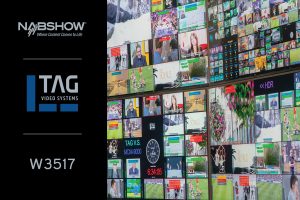NAB 2022: TAG Video Systems Spotlights New Media Control System, Extends SCTE Support
TAG Video Systems’ (Booth W3517) will be demonstrating the new Media Control System (MCS) and show attendees how the system is matchless in its ability to provide insights based on the open-source tools broadcasters need to extract real-time information and use it to enable improved operational performance. In addition, the company will
now support SCTE 104 along with supporting SCTE 35 cue triggers to provide one comprehensive monitoring solution for all SCTE needs.
Media Control System
The MCS is the newest layer of TAG’s Realtime Media Performance (RMP) Platform. It enables clients to capture the data provided by over 400 distinct error detectors to be aggregated and correlated across the entire media supply chain (from live production to playout, OTT & delivery). Media companies can now manage the entire monitoring stack, end-to-end within one system, that in turn will provide invaluable insights for optimum workflow performance.

Using an open-source paradigm, the MCS serves as an aggregation engine capable of exposing the data collected by TAG’s Multi-Channel Monitoring (MCM) to standard third party analytic and visualization applications such as Elasticsearch, Kibana, Grafana and Prometheus. This solution will enable companies to adapt to the rapid pace of change in technology and enable overall better business operations.
The MCM sits at the foundation of TAG’s software-based IP end-to-end monitoring, deep probing, logging, and real time visualization solution that monitors every type of signal from live production through OTT delivery and supports hundreds of sources including all the latest formats and transport methods. The MCM helps simplify the workflow complexity by providing an end-to-end view.
“Like so many of our innovations the MCS is another example of TAG being pushed by our clients,” says Kevin Joyce, TAG Video Systems’ Zer0 Friction Officer. “For years NAB was an essential ingredient in that customer engagement, and we are excited to once again be at a live and in person event and share where we are taking the RMP next with the market. The MCS gives new meaning to the phrase ‘Use it or lose it’. It truly is the only solution like it in the entire industry that empowers broadcasters and media companies with the tools they need to use their data for informed and intelligent decisions.”
“The MCS is the very embodiment of TAG’s Zer0 Friction philosophy that maximizes asset utilization, minimizes complexity, and manages the pace of change, while competitively enabling business operations,” adds Joyce. “Raw data is turned into a positive consumer experience with better curation, programming and integrity resulting in improved promotion, increased consumption, and more customers.”
TAG will also be demonstrating its support for compressed and uncompressed formats, including MPEG TS, JPEG- XS, CDI, NDI, JPEG2000, SMPTE 2110, SMPTE 2022-6/7, MPEG-DASH, HLS, SCTE and more.
SCTE Support
The enhancement provides media companies with a clear path to technical and business benefits by ensuring integrity of compressed and uncompressed SCTE signals throughout the entire workflow along with protection of revenue generating advertising streams.
The addition of SCTE 104 support enables TAG’s Realtime Media Performance Platform to read, monitor, and verify insertion trigger placement within uncompressed video streams during live production, playout and delivery of network program feeds. The enhanced functionality supplements the system’s already robust ability for broadcasters to confidently monitor SCTE 35 insertion triggers downstream within compressed video delivery platforms.
“Making support for SCTE available on the TAG Platform is a classic example of TAG’s Zer0 Friction philosophy,” explains Paul Briscoe, Chief Architect for TAG. “TAG provides one system with the technology to see SCTE triggers throughout the entire workflow which minimizes challenges and removes complexity. Uncompressed signals that had been monitored upstream can now be correlated from the very highest point of insertion in your system so monitoring can be achieved throughout the entire downstream workflow.”
In addition to the technical and operational benefits the functionality provides the broadcasters a better revenue protection method.
“SCTE triggers are the signals that digitally notify the downstream equipment to insert content, such as advertisements or local programming,” adds Briscoe “Since advertisements are the primary source of revenue for broadcasters, ensuring that commercials are inserted correctly is beyond critical. Monitoring SCTE, the mechanism that delivers content insertion, adds another layer of confidence and allows the team to concentrate on other tasks.”
